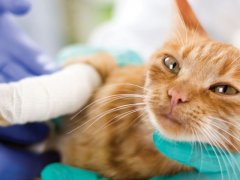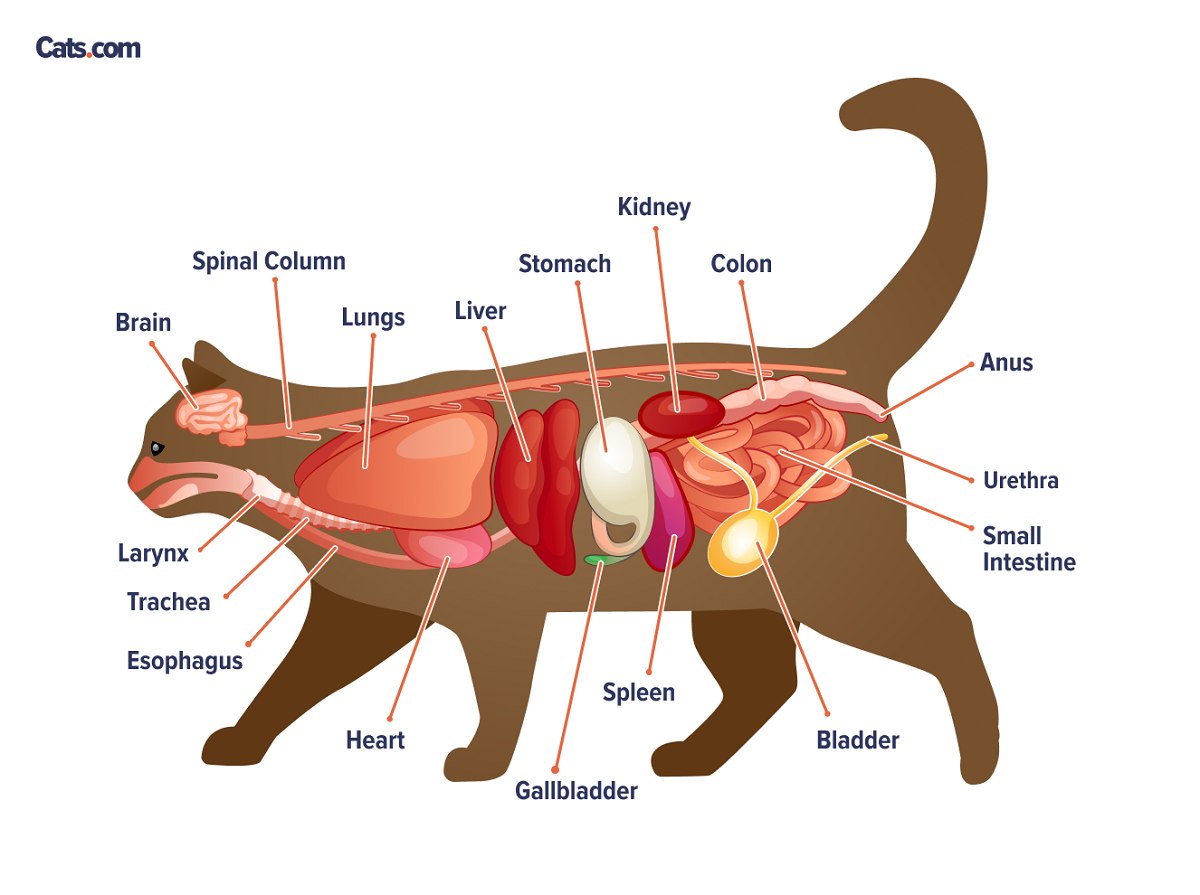
Sure, cats look cute and act cool, but it’s what’s inside that counts, right? Well, it turns out that cats have it all.
From their tip of their whiskers to the end of their tails, cats’ bodies have lots of funky features that make them really special. These features are the result of millions of years of evolution and (whether we like it or not) are what make them such exceptional hunters. It’s just a lucky coincidence that we find them adorable too.
Every aspect of your cat's anatomy is fine-tuned for their status as predatory animals. Cats have powerful senses of smell and hearing, making them keenly aware of their environment. Your cat's facial expressions, from whiskers to ears to eyes, can tell you how they're feeling.Key Takeaways
So, what are these fabulous feline features and where can they be found?
The Head and Neck
Eyes
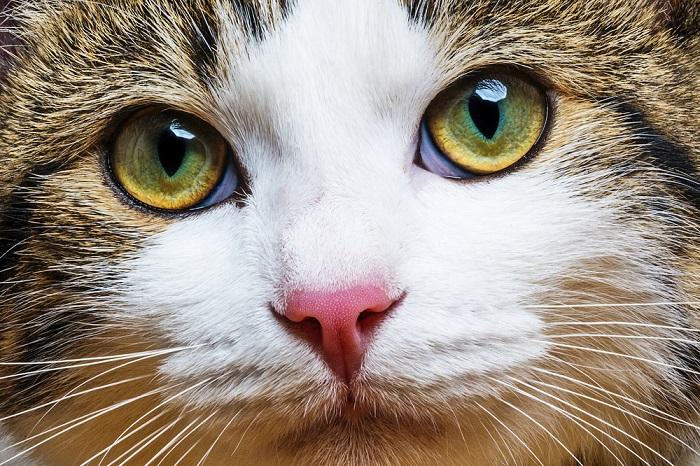
A cat’s eyes are large and well-adapted for their status as predators.
A cat’s eyes are large relative to their body size. They’re also positioned on the front of their face. This is typical of many predator species and gives them good binocular or 3D vision and helps them to accurately locate their prey.
The retina of the cat is made up of lots more rods (95%) than cones (5%), which means they can see well in low light. Another feature that gives them realty good night vision is the tapetum lucidum – a yellow layer at the back of the eye that reflects light (just like the cats’ eyes you see on the road).
As in other species, the iris of a cat’s eye can relax and constrict to change the amount of light coming in through the pupil. Unlike dogs and humans though, the pupil is a vertical slit shape, not circular. Researchers think this pupil shape allows for a much greater change in the pupil size the dilated and constricted states and is what allows them to hunt during both the day and night.1
People say the eye is the window to the soul. That is certainly is true of cats – their eyes can give you lots of clues as to whether they’re happy and healthy. Big wide eyes with dilated pupils can mean your cat is excited or scared, but squinty eyes might mean they’re in pain.
Cats have a third eyelid, or a nictitating membrane. It protects the surface of the eye and helps to keep it moist. If a cat is sick, this eyelid can sometimes be seen sitting across the eye.
Also Read: What Does It Mean When A Cat Winks At You?
Ears

Your cat’s ears are strong and mobile, allowing your cat to detect sounds from all around them. They also play a key role in communication.
Those pointy little triangles on the top of your cat’s head aren’t just utterly adorable to look at, they also direct sound down your cat’s ear canal to their ear drum. There are 32 little muscles attaching each ear pinna to a cat’s head, which allows them to twitch and move their ears slightly to accurately tell where the sound is coming from.
Movement of the ears is also very important in feline facial expression and communication. A cat with ears upright forward-facing ears is usually happy and relaxed. A cat that has its ears pointing out to the side or flattened against its head is probably feeling threatened, scared or in pain.
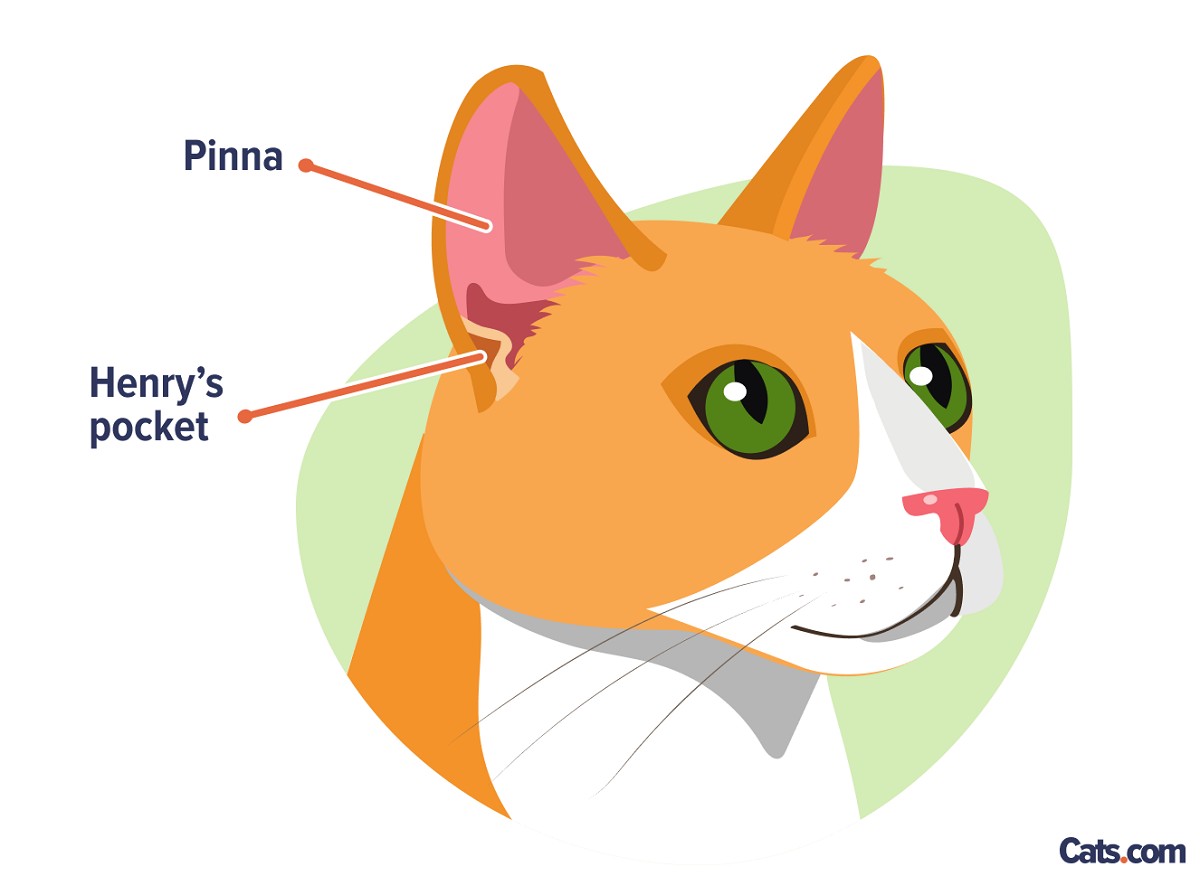
Cats have a little pocket of skin on the outer edge of their ear, called a Henry’s pocket. Its function is not fully understood, but scientists think it probably helps them to detect high pitched sounds in hunting. It’s a common place for pesky parasites such as harvest mites to hide, so be sure to check it out if your cat is scratching their ears.
Also Read: How To Clean A Cat’s Ears: A Simple 10-Step Process
Teeth
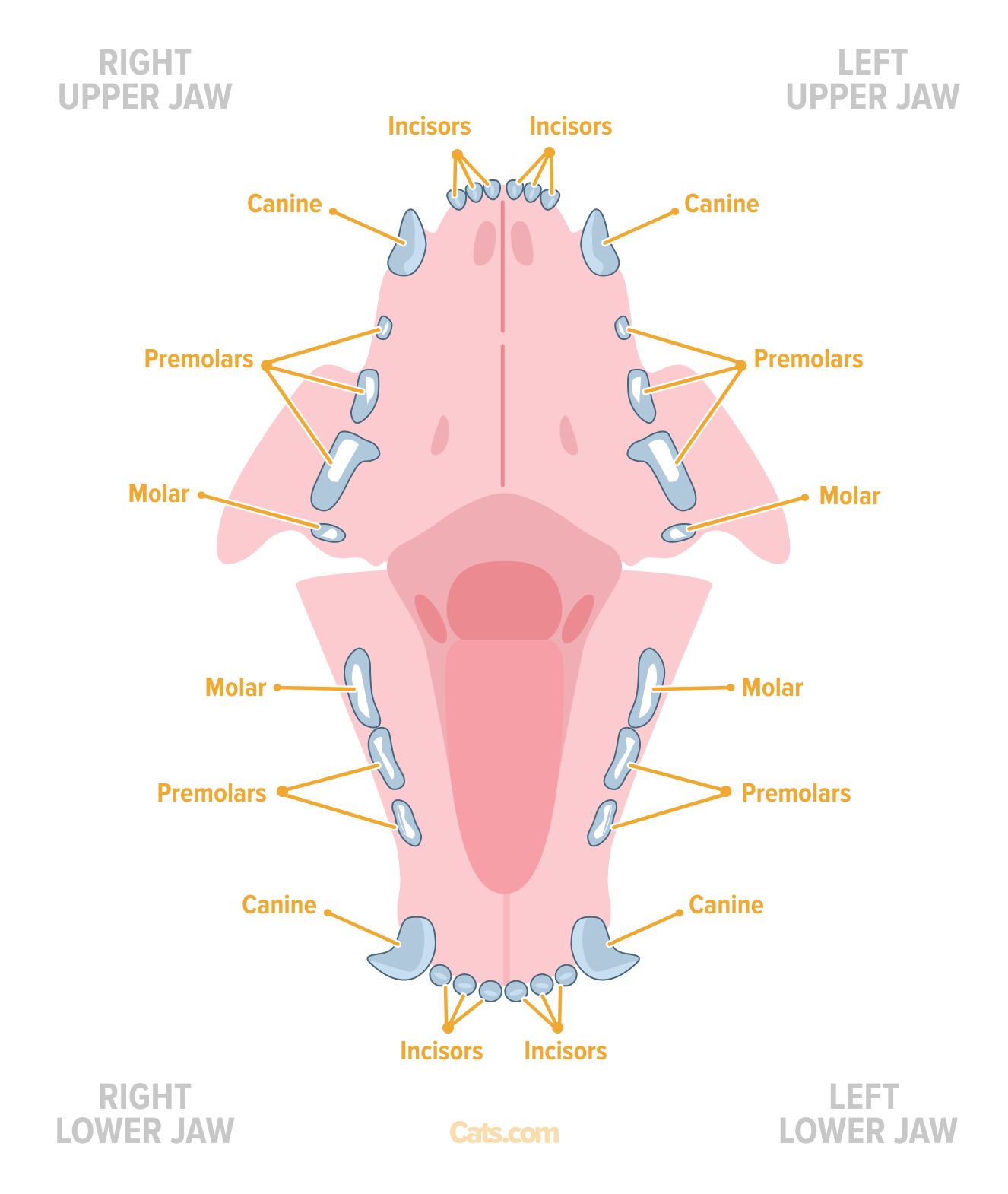
An adult cat has 30 teeth, broken into four categories—incisors, canines, premolars, and molars.
Just like us, kittens have baby (deciduous) teeth – 26 in total. They usually appear between 2-4 weeks of age, before you even welcome them into your home (so thankfully there’s no need to worry about sleepless nights with teething kittens!).
Cats usually have all their 30 of their adult teeth by 6 months of age. They have 4 different types of teeth, each of which have a different shape, location and purpose:
- Incisors – small pointy teeth at the front of the mouth, used for grooming and nibbling food.
- Canines – large sharp pointy teeth in the corners of the mouth, used for grasping and holding prey.
- Premolars – flatter teeth towards the back of the mouth, used for shearing and grinding food.
- Molars – these are similar to the premolars but a little larger.
You may hear people refer to the carnassial teeth. The biggest teeth in the jaw – these are the last upper premolar and the first lower molar on each side.
The tooth is made up mostly of dentine, is covered in enamel and has a central pulp cavity that contains the tooth’s nerves and blood vessels. Each tooth is held in the jaw by the periodontal ligament and surrounded by gum tissue. It’s these structures that become inflamed in cats with dental disease.
Also Read: How To Brush Your Cat’s Teeth
Tongue
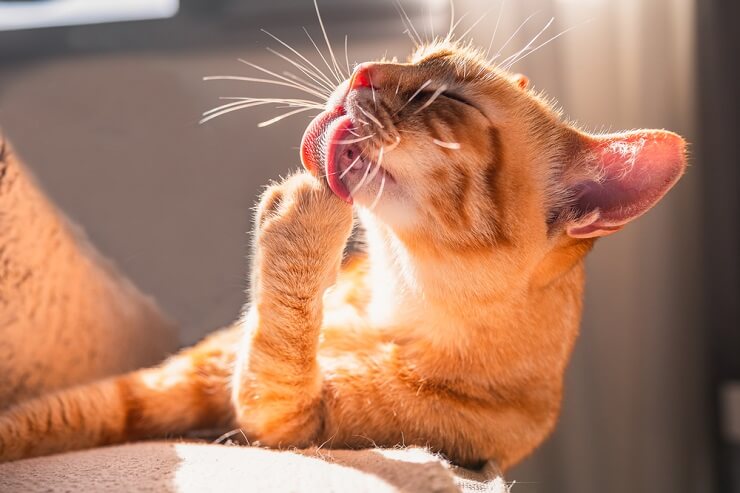
Your cat’s tongue is covered in tiny keratin hooks, allowing them to brush through their fur and get a thorough clean.
Cats are obligate carnivores – these means they must eat meat to survive. Unlike us, they are not attracted to sugary carbohydrates as they lack the receptors needed for tasting sweet things. They can, however, taste salty, sour, bitter and umami (savoury/meaty) flavours.
Cats use the tongue when vocalising and grooming. If ever a cat has licked you, you’ll know their tongue feels like sandpaper. That’s because it is covered in lots of tiny keratin hooks (called filiform papillae), which helps their tongue act like a hairbrush during grooming.
Unlike dogs, cats don’t stick their tongues out and pant to stay cool. But if they get too hot, they use their tongue to lick their fur, covering it in a layer of saliva to help them too cool down. The little hook-like papillae help with this too.
Also Read: 10 Little-Known Facts About Your Cat’s Tongue
Whiskers
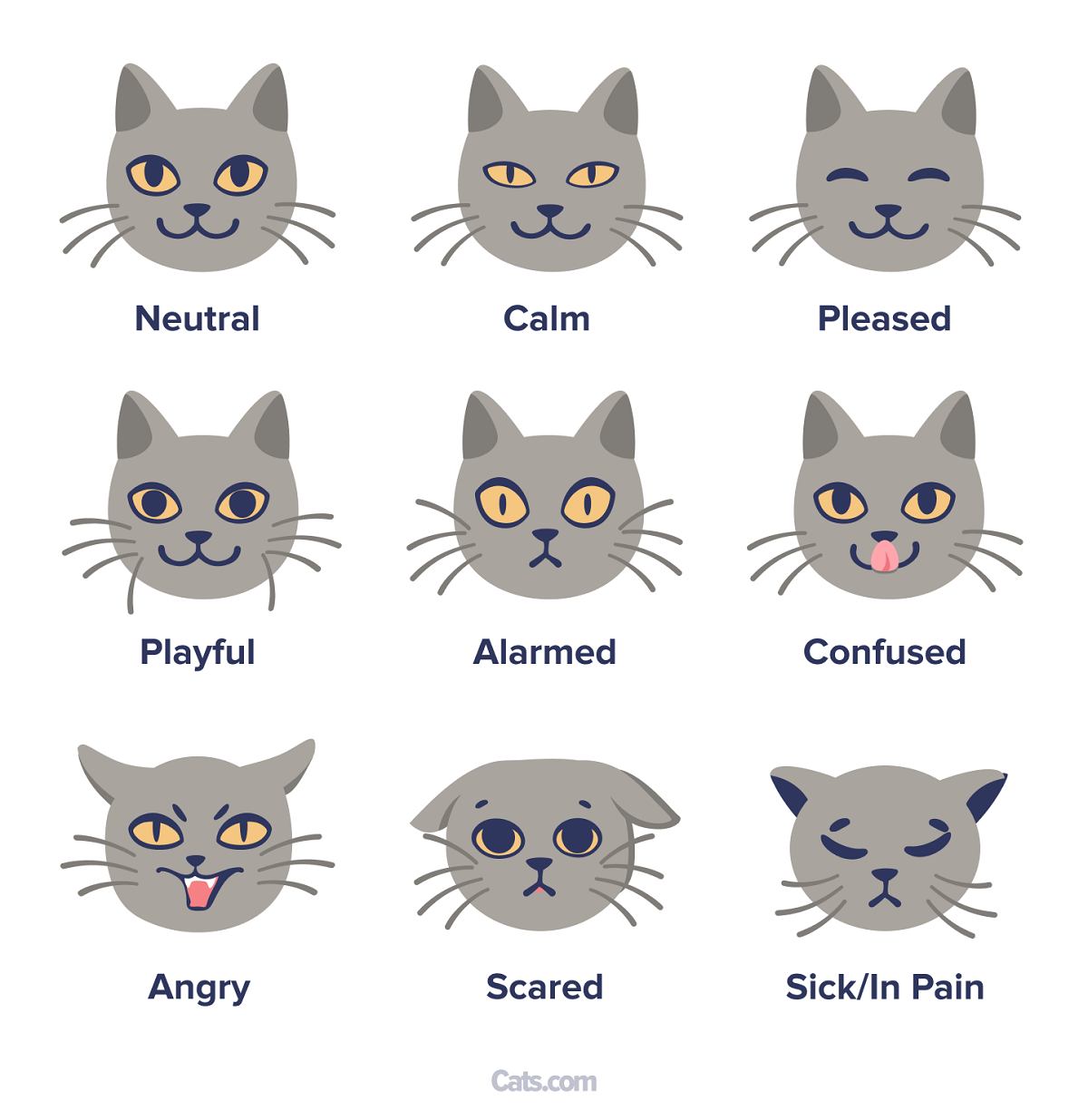
Whiskers, or to be technical about it, vibrissae, are highly sensitive and specialised hairs. They are thicker, longer, and more rigid than normal hairs, and can be found not only around your cat’s muzzle but on their chin, above their eyebrows and on the backs of their paws.
Also Read: Do Cats Shed Whiskers?
Whisker follicles are full of nerve endings meaning they can act like antennae – passing lots of information about your cat’s surroundings to their brain. This can help them to find their way in the dark and to locate prey too.
The super sensitivity of their whiskers is also why many cats prefer to drink from large or shallow bowls, or even puddles, as normal cat bowls are too deep or tight for their whiskers to comfortably fit into.
What’s more, you can tell a lot about a cat’s mood by looking at its whiskers. A relaxed and happy cat will have whiskers that are curved towards the ground whereas a cat with whiskers pulled back against their face is probably fearful or shy. When a cat is in pain, their whiskers might point forwards.
Also Read: 10 Surprising Facts About Cat Whiskers You May Not Have Known
Nose
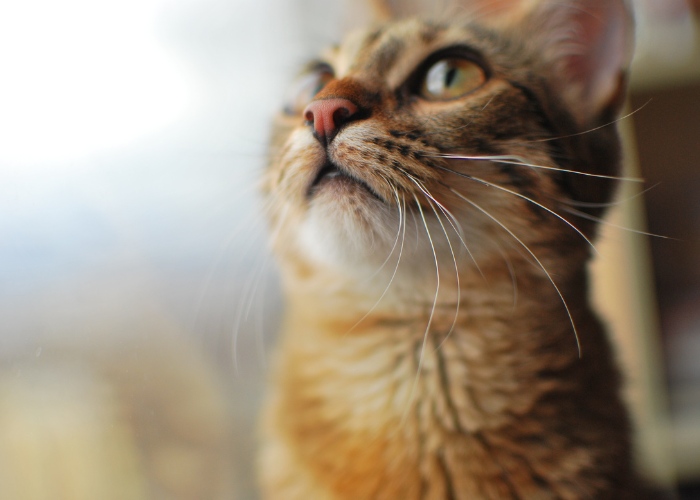
Cats have an excellent sense of smell, with as many as 200 million smell receptors in their noses.
You don’t need us to tell you your cat is one of a kind, but did you know – the pattern on their nose is unique to them, just like a human fingerprint?
Cats have a very good sense of smell – they can have up to 200 million smell receptors in their nose (compared just 5 million in people). Their sniffing superpowers can help them to find food, find their way home, to suss out if other cats are nearby and avoid things that might cause them harm.
A cat’s sense of smell is also really important for their appetite – just by warming up a poorly cat’s dinner a little, it can release the tasty odours and encourage them to eat.
Also Read: What Smells Deter Cats From Peeing?
A “Sixth Sense”: The Vomeronasal Organ
Cats really do have a sixth sense thanks to a special organ that sits in the roof of their mouth, just behind their front (incisor) teeth. The vomeronasal or Jacobson’s organ detects chemicals (pheromones) in the air which allow cats to pass messages to other cats about things such as territory and sexual arousal.
You can spot when your cat is sniffing or tasting these chemicals in the air – they hold their mouth slightly open, curl up their lip and wrinkle their nose a little. This is called the Flehmen response.
Also Read: Mouth Ulcers In Cats: Causes, Symptoms, and Treatment
Throat

Your cat’s throat allows them to purr!
Have you ever wondered how cats purr? That low gentle vibration sound is usually associated with a state of happiness and pleasure, but cats also purr to self-soothe when they’re feeling worried or in pain.
The purring sound is created by super-fast twitching of muscles in the cat’s larynx (or throat). Rapid narrowing and widening of the opening at the back of the throat causes respiratory air to vibrate and make a sound as it passes through.
Also Read: Why Do Cats Purr When They Sleep? A Vet Explains
Internal Organs
Digestive Tract
Cats’ bodies have evolved to digest and metabolise a meat-based diet. They are reliant on it to get all the nutrients they need. This includes high levels of protein and some specific amino acids, without which they can become very sick. For example, cats fed a diet deficient in the amino acid taurine can suffer blindness and heart disease.
In the cat, the bile duct and pancreatic duct open into the small intestine through one opening. It’s common therefore, for cats with an upset tummy to suffer from “triaditis” – a condition that involves inflammation of the pancreas, gall bladder and small intestine, all at the same time.
Also Read: Cat Digestive System: Anatomy, Diseases, & Treatment
Reproductive Anatomy
Cats are “induced ovulators” which means they need to mate to release an egg. The need to stimulate the queen’s reproductive tract in this way is the reason behind the rather strange anatomy of the tomcat penis.
Like the tongue, it is covered in lots of tiny spines or spikes made of keratin – the same stuff that makes up our fingernails! A small bone called an os penis is also found in more than one third of male cats.2
Also Read: Cat In Heat (Estrous Cycles): Signs, Symptoms & Care
Limbs and Tail
Paws and Claws
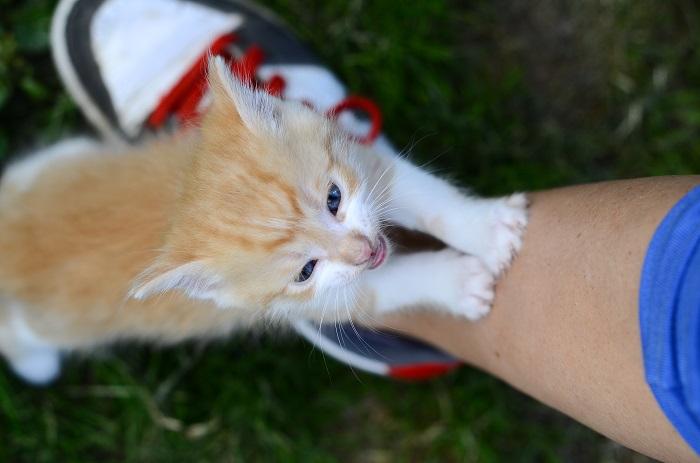
Even the smallest kitten’s paws and claws are made to perfection.
Just like the rest of them, cat’s feet are designed to perfection. Here’s some fun facts about their paws and claws:
- Cats have 5 toes on the front feet but just 4 on the back. The “extra” toe on the front helps them to do lots of cat-like things like holding onto prey or climbing trees. The curved shape of their claws can help with these things too.
- Whilst not in use, a cat’s claws are retracted into the paw. Once they’re needed, the cat can quickly unsheathe and expose the claw. A cat’s ability to retract its paws gets less as they get older, so it’s not uncommon for mature moggies to get their claws stuck in things like blankets or your clothing.
- Their cute little “toe beans” (footpads) are also special. They have one on each toe and another larger, central, metacarpal or metatarsal pad. These footpads are like built in shock absorbers for when cats land on their feet and can help with balance.
- Cat feet are very sensitive. They can help a cat to gather lots of information about their environment – the surface they’re walking on and the temperature too – they can even detect tiny vibrations to help with hunting down prey.
- The feet are the only place your cat has sweat glands. Ever noticed they leave sweaty paw prints on the examination table at the vets? Well, now you know why.
Also Read: Do Cats Have Scent Glands In Their Paws?
Tail

Your cat’s tail is part of their skeletal anatomy, accounting for 10% of all the bones in the body!
A cat’s tail accounts for 10% of all the bones in their body, and in most cats is around 30cm long. Their long tail acts as a counterweight, helping cats to balance. It’s important for communication too – the shape and movement of your cat’s tail can tell you a lot about their mood. It’s also thought that a swishy tail helps cats to mesmerise their prey.
Also Read: What Your Cat’s Tail Can Tell You
So, there you have it – a whole list of reasons why your cat really is cool, according to science (if ever you were in doubt!).
-
Banks MS, Sprague WW, Schmoll J, Parnell JA, Love GD. Why do animal eyes have pupils of different shapes? Sci Adv. 2015 Aug 7;1(7):e1500391.
-
Piola V, Posch B, Aghte P, Caine A, Herrtage ME. Radiographic characterization of the os penis in the cat. Vet Radiol Ultrasound. 2011 May-Jun;52(3):270-2



